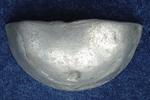St Anthony's Finds Record
Kevin Camidge, 2008. https://doi.org/10.5284/1000358. How to cite using this DOI
Data copyright © English Heritage unless otherwise stated
This work is licensed under the ADS Terms of Use and Access.
Primary contact
English Heritage
Kemble Drive
Swindon
SN2 2GZ
England
Tel: 01793 414700
Fax: 01793 414707
Resource identifiers
- ADS Collection: 847
- DOI:https://doi.org/10.5284/1000358
- How to cite using this DOI
Introduction

The project aimed to provide a record of the finds recovered from the designated wreck site the St. Anthony. Described as a "fine ship" belonging to King John III of Portugal, the St. Anthony was wrecked on 19th January 1527 while sailing from Flanders to Portugal. The vessel had a crew of 86 and was carrying a valuable cargo - including silver and copper ingots, candle sticks, bowls and fine cloth.

The wreck is situated a short distance offshore from Gunwalloe Fishing Cove, on Lizard, Cornwall. The wreck was discovered in the late 1970s by a local shellfish diver. It was probably exposed as a result of aggregate extraction from the beach which continues to the present day. It came to the attention of Richard Larn in 1981, in which year he and a group of local divers started underwater investigation of the site. A number of artefacts were recovered which led them to identify the wreck as that of the St. Anthony.





